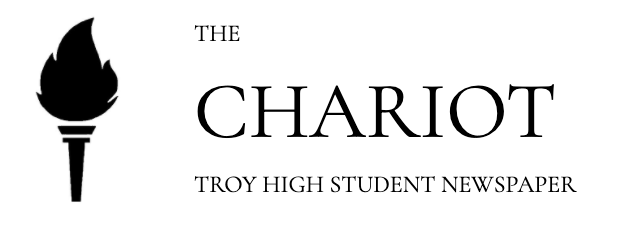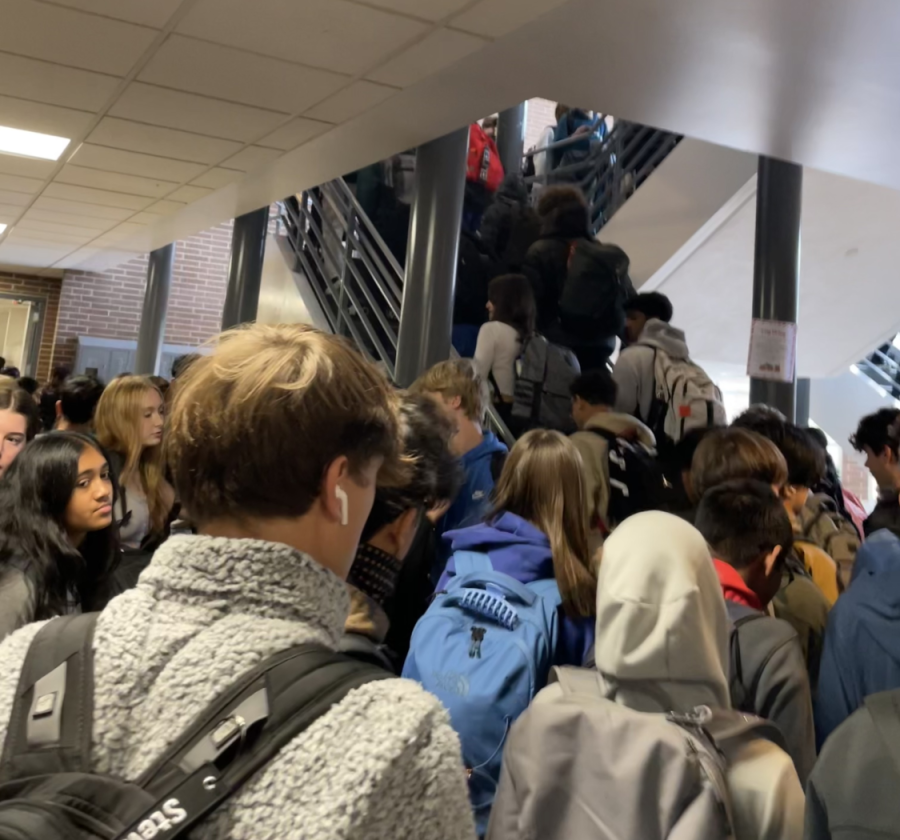Objects in the Mirror Are Closer Than They Appear
Reasons to be cautious of a seemingly far threat that can apply to Troy High School.
The crowded, hard-to-navigate hallway near the main stairs in Troy High School.
On the night of Oct. 29, 2022, a tragic event resulting in approximately 158 deaths and 200 non-fatal injuries of young people occurred in Itaewon, a neighborhood in Seoul, South Korea at a Halloween festival. As a result, South Korea held a mourning period of a week, which ended on Nov. 5 at midnight. One year ago on that same day, a similar event occurred during the 2021 Astroworld Festival founded by musician Travis Scott in Houston, Texas. The first night of the music event ended with the deaths of 10 attendees.
Both of these tragic events share the same cause: crowd crushes. But what really are crowd crushes and how are they fatal?
According to the Washington Post, a crowd crush occurs when “people are packed together in a confined space and there’s movement such as pushing that causes the crowd to fall over.” Many fatalities in these crushes are by compressive asphyxiation, which is suffocation due to pressure on the airways, blocking the ability to breathe.
Other than fatalities, crushes can result in many injuries. Some examples provided by the Washington Post include “broken ribs and fractures or spinal cord injuries” and damage to organs “particularly to the lungs and heart, as well as internal bleeding or muscle damage.” Such muscle damage can have detrimental effects such as “a life-threatening condition that occurs when muscle tissues release proteins and electrolytes into the blood, damaging the heart or kidneys.”
Science teacher Kyle Larson talks about his recent experiences with being in a dangerous crowd.
“I was at a concert and after the show was over, there was a mad rush of people to leave, and I got knocked over. When that happened, I ended up dislocating my kneecap.”
While Larson did not suffer from life-threatening injuries, his experience at the event had not ended positively.
“I had to be carted away on this wheelchair because I couldn’t walk. I had to sit in this tent with ice on my knee for an extra half hour, and then we ended up being really late getting home.”
Bad crowds seem to occur mainly at major events like festivals, parades and concerts, but they’re much closer than they appear. Though the Astroworld Festival crowd crush and the Itaewon Halloween crowd crush may have occurred hundreds of miles away, crowd safety still can be applied to the densely-packed hallways of Troy High School.
Junior Karina Pirzada describes her encounters with large crowds at Troy High School.
“The hallways here, especially during passing time in front of the main staircase, gets very, very crowded,” said Pirzada. “ It can be difficult to get around everyone and you kind of get shoved one way or another.”
Junior Samridhi Sharma also shares similar experiences with crowds at Troy High School.
“I was trying to get through to get to the art hallway, and then at one point, I literally couldn’t move and I was being pushed by the crowd. That was my only way of motion.”
Other than being pushed and shoved, there can be other unfortunate experiences that can occur in the hallways. Pirzada shares that she has not only been pushed but also had her hair get “caught on someone’s bag” and was “dragging along with them.”
Crowd crushes have been occurring since A.D. 66 when the first recorded crowd crush was estimated to have resulted in over ten thousand deaths, yet many were not aware of safety hazards that come along with large crowds.
Sharma talks about the level of knowledge she formerly had until the recent tragedies.
“I don’t think I was that informed. I know the thing that happened at that concert [Astroworld] last year, but I didn’t know it was a crowd crush,“ Sharma stated, “But this year after the thing happened in Itaewon, I was thinking about it more seriously. I heard of people climbing up walls to escape, and I didn’t realize it could be that hard on people. I did not know it could be that serious.”
Even with the recent crowd crushes that have occurred in the past two years, resources on how to stay safe are hard to find. The Centers for Disease Control and Prevention states a total of 11 steps to stay safe in crowd crushes or stampedes in “Mass Gatherings” in “Advice for Travelers”, a section that contains over 30 other pages under the “Travelers Health” homepage.
Pirzada talks about the accessibility of such government resources.
“To anyone who has access to electronic devices, the website [CDC] is easily accessible. Some people, however, who may not have electronics or Wi-Fi would obviously not be able to read the article online,” she says, “some people wouldn’t know where to look for such information or wouldn’t bother looking in the first place. ”
Though government resources on crowd safety may not be accessible for those who don’t know where to look, the CDC provides important crowd safety information that may save lives.
Here are the protective measures that the CDC has shared:
Follow these steps during your trip to protect yourself:
- Pay attention to your surroundings, including large crowds.
- Locate emergency exits upon arrival
- Identify where to obtain emergency medical services on site, if needed
- Arrange a place to meet your family or travel companions in case you are separated
- If there is a fire, crouch down low to get oxygen since heat and smoke rise
Follow these steps if you are stuck in a stampede, or crowd crush:
- Keep your hand in front of your chest like a boxer and keep firm footing
- Don’t resist the force of the crowd
- When there is a lull in movement, work your way diagonally to the edge of the crowd
- Try to stay on your feet
- If you fall down, protect yourself by curling into a ball
- Stay calm and get up as soon as you can.
Though the crowds of the densely-packed hallways of Troy High School may not pose as big of a threat as the Astroworld Festival crowd crush and the Itaewon Halloween crowd crush, it’s important to keep in mind that objects in the mirror are closer than they appear.
Your donation will support the student journalists of Troy High School - MI. Your contribution will allow us to print our work, purchase equipment and cover our annual website hosting costs.


